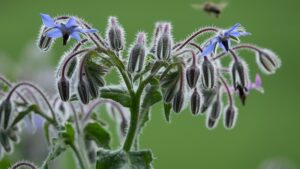Growing borage is surprisingly straightforward and can be a delightful addition to both your garden and your pantry. Begin by sowing the seeds in well-drained soil under full sunlight; borage prefers warmer climates, but it’s fairly adaptable and can grow in cooler areas. This annual herb germinates within 5 to 15 days, and the plants should be spaced about 12 inches apart to allow for ample growth.

Introduction to Borage
Borage, scientifically known as Borago officinalis, is an herb that has been used in various cultures for centuries. It is believed to have originated from the Mediterranean region but can now be found all over the world. Borage is also commonly known as starflower, bee bread, and bee plant due to its attractive blue star-shaped flowers that are loved by bees.
Historical Context of Borage as a Herb
Borage has a rich history in herbal medicine and culinary use. In ancient times, borage was believed to have healing properties for various ailments such as fevers, respiratory issues, and anxiety. Its leaves and flowers were also commonly used to make teas, tonics, and poultices for skin irritations and wounds.
Cultivating Borage
Borage is a self-seeding plant, meaning it will drop its own seeds and continue to grow year after year if left undisturbed. It is an easy plant to grow and can tolerate a range of soils, making it perfect for beginner gardeners. Its bright blue star-shaped flowers also make it a beautiful addition to any garden.
Ideal Growing Conditions for Borage
To optimize borage’s growth, it thrives best in a well-drained soil with a pH ranging from 6.0 to 7.0. Although borage is quite resilient and can endure a variety of soil types, adding organic matter can enhance soil fertility and moisture retention. Full sun is preferable for borage, but it can also tolerate partial shade. Regular watering will support its rapid growth pattern, although once established, borage has good drought resistance. It’s recommended to space plants about 12 inches apart, as borage can spread quite extensively and reach up to two or three feet in height.
Planting Tips for Borage
When planting borage, consider starting the seeds indoors about 3-4 weeks before the last frost date for an early start. Use small pots filled with seed starting mix and place the seeds at a depth of about 1/4 to 1/2 inch. Keep the soil moist but not waterlogged, and provide plenty of light once the seeds germinate. Harden off the seedlings by gradually introducing them to outdoor conditions over several days to prevent shock before transplanting them into the garden.
Seed Propagation
Borage seeds can also be sowed directly into the garden once the threat of frost has passed. To do this, scatter the seeds on prepared soil and lightly cover them with soil. Water the area gently and consistently until seedlings emerge. Thin the borage seedlings to about 12 inches apart to give each plant room to grow. Due to its self-seeding nature, borage may pop up in the following growing seasons without any need to replant, providing a continual bounty of this beneficial herb.
Maintenance and Care for Borage Plants
Regular maintenance is essential to ensure the healthy growth of borage plants. Deadheading the spent flowers can encourage more blooms and prevent excessive self-seeding if you wish to control the spread of borage in your garden. While borage is relatively low-maintenance once established, monitoring for signs of overwatering, such as wilting or yellowing leaves, is important. Mulching around the base of the plants can help maintain soil moisture and temperature, and prevent the growth of weeds.
Common Pests and Diseases Affecting Borage Plants
Borage plants are generally hardy, but they can be susceptible to certain pests and diseases. Common pests include aphids and spider mites, which can be controlled naturally with a strong spray of water or by introducing beneficial insects such as ladybugs. Powdery mildew is a common fungal disease that can afflict borage, particularly in humid conditions; it appears as a white powdery substance on the leaves. Ensuring good air circulation around plants and reducing overhead watering can help prevent this fungal issue. If infection occurs, organic fungicides may be used carefully as a last resort.
Harvesting Borage
Borage leaves and flowers are best harvested in the morning after the dew has evaporated but before the heat of the day sets in. This timing helps ensure that the plant’s oils, responsible for its distinctive flavor and health benefits, are at their peak. Young borage leaves are more tender and palatable, ideal for culinary uses, while the vibrant blue flowers can be picked as they open. Frequent harvesting encourages the plant to produce new growth, extending the harvesting season.
Proper Storage Techniques for Maximum Freshness and Flavor
Once harvested, the freshness and flavor of borage can be maintained through proper storage techniques. Leaves should be gently washed and patted dry, then wrapped in a damp paper towel and placed inside a plastic bag or container. They can be refrigerated for up to a week. Borage flowers, on the other hand, are more delicate and should be used immediately if possible; however, they can also be stored in a similar fashion to the leaves for a few days. Drying and freezing are alternative methods—dried borage leaves retain their flavor and are perfect for brewing tea, while frozen leaves and flowers can be used in culinary applications where a fresh appearance is not paramount.
Utilizing Frozen or Dried Borage in Culinary and Medicinal Uses
Borage’s versatility shines not only when it’s fresh but also in its frozen or dried forms. Frozen borage leaves can be chopped and added to soups, stews, or casseroles, where they impart a mild cucumber-like flavor. For a refreshing twist, frozen borage flowers make a beautiful edible garnish in iced drinks or cocktails. When it comes to dried borage, it’s often utilized in herbal tea blends for its reputed soothing properties that may help with stress and adrenal support. Dried leaves can also be ground into a powder and sprinkled over dishes as a seasoning or incorporated into homemade salves and balms for topical application, taking advantage of borage’s anti-inflammatory benefits.
Benefits of Borage Oil for Skincare
Borage oil is extracted from the seeds of the borage plant and is rich in essential fatty acids such as gamma-linolenic acid (GLA). This makes it a popular ingredient in skincare products as it has anti-inflammatory and moisturizing properties. Borage oil can help improve skin elasticity, reduce redness and irritation, and promote healthy cell regeneration.
Culinary Uses of Borage
Borage leaves and flowers have a mild cucumber-like flavor, making them a refreshing addition to salads, drinks, and soups. The flowers can also be candied and used as a decorative garnish for desserts. In addition, borage leaves can be cooked like spinach or added to pesto for a unique flavor twist.
Borage in Modern Herbal Medicine
While borage may not be as commonly used in modern herbal medicine, it still holds its place in traditional remedies. Its flowers and leaves are believed to have anti-inflammatory and diuretic properties, making them helpful in treating conditions such as rheumatoid arthritis and urinary tract infections. Some studies have also shown that borage can help lower blood pressure and cholesterol levels.
Medicinal Properties of Borage: Anti-inflammatory and Adrenal Support
Borage exhibits notable anti-inflammatory properties, primarily due to its high gamma-linolenic acid (GLA) content. GLA is a type of Omega-6 fatty acid that, when consumed, can convert to a potent anti-inflammatory prostaglandin E1, which soothes and reduces inflammation in the body. This can be particularly beneficial for those with conditions exacerbated by inflammation, such as arthritis or skin disorders like eczema. Additionally, borage has been traditionally used to provide adrenal support. It stimulates the adrenal glands, helping to regulate the stress response and balance mood. This can offer a source of relief for those experiencing stress and related adrenal fatigue.
Companion Planting with Borage in the Garden
Companion planting with borage offers numerous benefits to gardeners, contributing to a healthier and more productive garden ecosystem. As a companion plant, borage helps to attract beneficial pollinators, such as bees, which are essential for the pollination of many fruits and vegetables. Moreover, borage is known to repel certain pests, reducing the need for chemical pesticides. Its deep roots are excellent at mining minerals and nutrients from the soil, bringing them closer to the surface, where they can be accessed by plants with shallower root systems. This natural process of nutrient cycling enriches the soil, leading to a more bountiful and sustainable garden yield.
Borage Oil in Skincare and Health Supplements
Borage oil, derived from the seeds of the borage plant, has gained considerable recognition in the fields of skincare and dietary supplements. Rich in gamma-linolenic acid (GLA), borage oil is a powerful ingredient in numerous moisturizing creams and serums. Its ability to restore moisture and strengthen the skin’s natural barrier makes it ideal for treating dry, irritated, or aging skin. Furthermore, as a health supplement, borage oil capsules can support the body’s anti-inflammatory processes and promote overall well-being. When incorporated into a balanced health regimen, borage oil supplements may aid in managing conditions such as premenstrual syndrome (PMS) and atopic dermatitis due to its high concentration of beneficial fatty acids.
Conclusion
Borage may be a lesser-known herb, but its benefits and uses are abundant. From skincare to culinary dishes, this versatile plant has been valued for centuries and continues to be a valuable ingredient in modern times. Whether you’re looking for a natural way to improve your skin’s health or add a unique flavor to your cooking, borage is definitely worth considering. So why not give it a try and see the benefits for yourself? Happy gardening and happy cooking! Remember to always do your research and consult with a healthcare professional before using any
Growing borage is surprisingly straightforward and can be a delightful addition to both your garden and your pantry. Begin by sowing the seeds in well-drained soil under full sunlight; borage prefers warmer climates, but it’s fairly adaptable and can grow in cooler areas. This annual herb germinates within 5 to 15 days, and the plants should be spaced about 12 inches apart to allow for ample growth.

